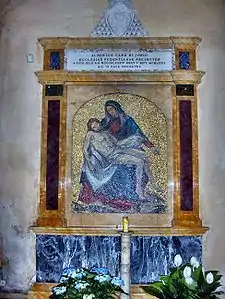Alberto di Jorio
Alberto di Jorio (18 July 1884 – 5 September 1979), was a cardinal of the Catholic Church and for many years along with the layman Bernardino Nogara the powerhouse behind the growing wealth of the Vatican and the Istituto per le Opere di Religione (popularly known as the "Vatican Bank").

Alberto di Jorio | |
|---|---|
| Pro-President Emeritus of the Pontifical Commission for the Vatican City State | |
| Church | Roman Catholic Church |
| Appointed | 14 August 1961 |
| Term ended | 4 November 1968 |
| Successor | Sergio Guerri |
| Other posts | Cardinal-Priest of Santa Pudenziana (1967–1979) |
| Orders | |
| Ordination | 18 April 1908 |
| Consecration | 19 April 1962 by Pope John XXIII |
| Created cardinal | 15 December 1958 by Pope John XXIII |
| Rank | Cardinal-Deacon (1958–1967) Cardinal-Bishop (1967–1979) |
| Personal details | |
| Birth name | Alberto di Jorio |
| Born | 18 July 1884 Rome, Kingdom of Italy |
| Died | 5 September 1979 (aged 95) Rome, Italy |
| Buried | Santa Pudenziana |
| Previous post |
|
| Alma mater | Pontifical Roman Seminary |
| Motto | Innova |
| Coat of arms |  |
| Styles of Alberto di Jorio | |
|---|---|
 | |
| Reference style | His Eminence |
| Spoken style | Your Eminence |
| Informal style | Cardinal |
Early life
From his earliest years di Jorio was destined for a career in the Roman Curia. He entered the most prestigious of Roman seminaries, the Pontifical Roman Seminary, and after becoming a priest in 1908 soon took up a role as an official in the vicariate of Rome. Despite doing some work as a pastor in Rome, di Jorio was always chiefly concerned with his work in the Vatican bureaucracy, and in 1918 he took up a role as president of the Istituto per le Opere di Religione ("Institute of Religious Works").
Under the direction of Pope Pius XI, who was eager to settle the "Roman Question" that had kept the Pope as a "prisoner of the Vatican" since Italian unification in 1870, di Jorio formed a close association with Bernardino Nogara in the 1920s. After the Lateran Treaty settled the "Roman Question" and made the Vatican an independent state, di Jorio was chosen by Nogara to run the Vatican Bank, and aided by laws that allowed Nogara to freely buy shares in any company even if it made products contrary to Catholic Church teaching, the Vatican grew immensely wealthy, buying extensively into such wealthy corporations as General Motors, Standard Oil, General Electric and IBM – as well as Italgas, the major supplier of gas in Italy at the time.
Episcopal career
Father di Jorio (later a Monsignor) continued to run the Istituto per le Opere di Religione (and did so until after Vatican II) but he also played many other roles in the Curia during these years, most notably becoming Secretary of the Sacred College of Cardinals in 1947. He was secretary of the conclave during the election of Pope John XXIII, who put his zuchetto on di Jorio's head at the end of the conclave, a traditional promise that he would make di Jorio a cardinal. Six weeks after the conclave, di Jorio was elevated to Cardinal-Deacon of S. Pudenziana in the consistory of 15 December 1958. He was later consecrated Titular Archbishop of Castra Nova on 19 April 1962 when Pope John decreed that all cardinals had to be bishops. He opted for the order of Cardinal-Priests and his deaconry was restored to title on 26 June 1967.
Cardinal di Jorio participated in the Second Vatican Council and in the conclave of 1963 that elected Pope Paul VI. Although already seventy-nine at the time, he continued as effective head of the Vatican Bank until 1968. He was prohibited from participating in the two 1978 conclaves because of his age. Upon the death of José da Costa Nunes on 29 November 1976, di Jorio became the oldest member of the College of Cardinals. Pope Paul VI preached a special homily for him on the seventieth anniversary of his priestly ordination.
References
- Sources
- Yallop, David; In God's Name: An Investigation into the Murder of Pope John Paul I (Poetic Product Limited: 1984), pp. 146–16.
External links
| Records | ||
|---|---|---|
| Preceded by José da Costa |
Oldest living Member of the Sacred College 29 November 1976 – 5 September 1979 |
Succeeded by Antonio Caggiano |